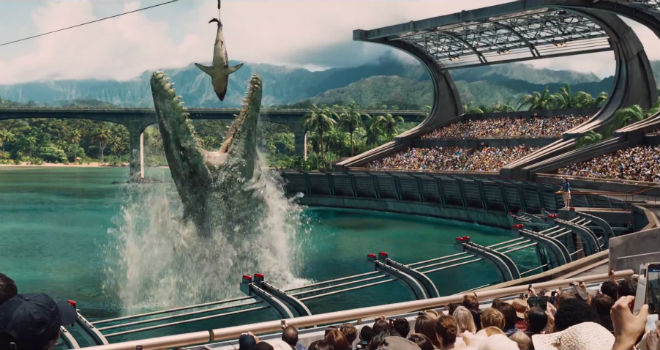In a film like “Jurassic World,” How Much Should be Based in Fact?
Whenever a film like Jurassic World (2015) is released the scientific community and paleontologists often criticize its factual shortcomings. Perhaps they should be reminded that Jurassic World is just a movie and Jurassic Park (1993) is probably the reason they became paleontologists in the first place. On the other hand, if Jurassic Park and the dinosaurs depicted onscreen was not based in scientific fact, what would we all think dinosaurs actually look like? Science fiction films like Jurassic Park incredibly influence public perception of science and history; thus, filmmakers should be cognizant that they wield great power in how they represent the facts.
If Steven Spielberg or Michael Crichton (the author of the book Jurassic Park) neglected to do their research and instead took creative license in depicting dinosaurs with bright pink fur, possessing four eyes or only communicating telepathically, then the massive audiences that flocked to theaters to see this blockbuster franchise may have a wholly inaccurate understanding of what dinosaurs looked like.
According to National Geographic “The original movies brought the dinosaur research of the 1980s to 1990s viewers…And the latest one seems to bring the dinosaur research of the 1980s to the 2010s viewers.” As the first Jurassic Park came out in 1993 the research they used to support the film was probably quite accurate, but for some reason they chose not to bring Jurassic World up to speed. “The decades since the first Jurassic Park movie have brought a pile of dinosaur discoveries to center stage in paleontology. Chiefly, scientists have learned that plumage of all stripes, shapes, and sizes, from insulating tufts to decorative barbs to fully developed feathers, adorned most dinosaurs dating back to the earliest ones” says Nat Geo.
As the world of Jurassic World takes place in current day 22 years after the original park/film it would make sense that scientists in the movie have made the same discoveries that real world scientists have made in that time span and would have chosen to update their dinosaurs, yet the filmmakers instead choose to wow their viewers with a genetically modified T-Rex that’s part frog, cuddle fish, velociraptor, and dragon for all we know.

Perhaps Spielberg and his new director Colin Trevorrow decided that they didn’t want to scare away viewers with updated dinosaurs and decided to play it safe. But now Jurassic World has become the largest box office release in history and the countless people who have seen it (a good chunk of the world) will now probably have a skewed perception of what a dinosaur really is. As stated earlier perhaps filmmakers need to take responsibility for the influence they have when it comes to things that are more fact than opinion; although films are equally meant to inspire as they are to teach and bits of both can be found in some of the great science fiction films in history.
Ridley Scott’s Alien (1979) warns us against contact with sentient species beyond Earth, but the film’s setting, the ship Nostromo, is not a sparkly gleaming U.S.S. Enterprise, but a cramped vessel filled with exposed hydraulic pipes and hibernation pods which “shows a future where space will become part of industrial fabric. It will be a common working environment, some-times boring, some times dangerous, like an offshore oil rig -not an exotic lab” says Popular Mechanics. While Gattaca (1997) seemingly predicts the future of genetic modification with accuracy and scientific basis it also predicts the prejudice and possible fascism it might lead to.
Of course the most painstakingly accurate of them all, Kubrick’s 2001: A Space Odyssey (1968), cautions us to the downfalls of artificial intelligence but also “predicts the ambitions of the private space flight industry.” The Nostromo, Space X, and genetic mapping and predisposition are all aspects of their respective movies that the filmmakers took time in creating. They have a factual basis and not only predict the future but instruct and excite audiences to the possibilities of science as well as technology that researchers are probably working on as we speak. On the other hand a dangerous Alien stowaway, a homicidal computer, and the rise of genetic classicism are leaps beyond fact that the filmmakers made in order to educate those on the possible, yet unknowable, future that may arise as well as to perhaps inspire people to dream beyond what science can achieve today.

Almost all the paleontologists interviewed in the National Geographic article acknowledged they would see the movie when it is released despite their reservations. Even though Jurassic World is mostly devoid of scientific advancement it has been seen by hundreds of millions of people and if changing the look of the dinosaurs would have discouraged people from seeing it that would have been a shame as the rebooted film could again fill paleontology classrooms like its predecessors regardless of its factual missteps. But science fiction, as the name implies, is a dichotomous genre and although the two aspects of the genre are opposing they should also be represented equally.

